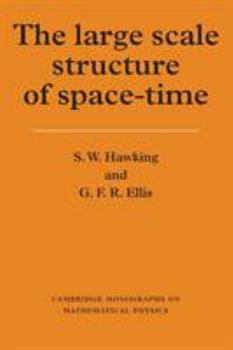The Large Scale Structure of Space-Time
(Part of the Cambridge Monographs on Mathematical Physics Series)
Select Format
Select Condition 
Book Overview
Einstein's General Theory of Relativity leads to two remarkable predictions: first, that the ultimate destiny of many massive stars is to undergo gravitational collapse and to disappear from view,... This description may be from another edition of this product.
Format:Paperback
Language:English
ISBN:0521099064
ISBN13:9780521099066
Release Date:March 1975
Publisher:Cambridge University Press
Length:404 Pages
Weight:1.30 lbs.
Dimensions:0.8" x 6.0" x 8.9"
Customer Reviews
4 ratings
The Large Scale structure of good science books ( & spacetime
Published by Thriftbooks.com User , 22 years ago
I think that this book has great depth, and is one of the best Stephen Hawking books I have read. My favourite remains 'A Brief History of Time', but still this book is extremely excellent. My compliments to the chef.
A classic in mathematical general relativity
Published by Thriftbooks.com User , 22 years ago
This book is now a classic and is written by two giants in mathematics and physics. It wil be used for many years to come and is certainly one of the most widely quoted in the subject. The authors begin the book by a discussion of the role of gravity in physics and its role as determining the causal structure of the universe. They introduce the idea of a closed trapped surface, setting the stage for the goal of the book, namely the study of the conditions under which a space-time singularity must occur. Black holes and the beginning of the universe are cited as examples of these singularities. The authors also outline briefly the content of each chapter. A neat argument is given for the significance of focal points via the use of Raychaudhari's equation. The second chapter is an overview of the background in differential geometry needed in the rest of the book. Although complete from an axiomatic point of view, the approach is much too formal for readers who do not have a knowledge of differential geometry. Such a reader should gain the necessary background elsewhere. General relativity as a theory of gravitation is discussed in chapter 3. Spacetime is assumed to be a connected 4-dimensional smooth manifold on which is defined a Lorentz metric. The topology is assumed to be Hausdorff. Some of the more interesting or well-written parts of this chapter include the example of a spacetime that is not inextendible, the determination of the conformal factor for the spacetime metric, and the discussion of alternative field equations. The authors discuss the physicial significance of curvature in chapter 4, namely its effect on families of timelike and null curves. The most important part of this chapter is the discussion on certain inequalities tht the energy-momentum tensor should satisfy from a physical viewpoint. These inequalities, called the weak energy condition and the dominant energy condition, allow the authors to prove the existence of singularities in a later chapter. The reader can see clearly the role of the Jacobi equation, and its solution, the Jacobi field, in measuring the separation of nearby geodesics. The existence of conjugate points is proven, and shown to imply the existence of self-intersections in families of geodesics. As a warm-up to showing the non-existence of geodesics of maximal length, the authors employ variational calculus to study how to vary non-spacelike curves connecting points in convex normal neighborhoods in spacetime, and between points and hypersurfaces. In particular, it is shown that a timelike geodesic curve from a hypersurface to a point is maximal iff there is no conjugate point to the hypersurface along the curve. In addition, the authors prove that two points joined by a non-spacelike curve which is not a null geodesic can be joined by a timelike curve. The authors consider the exact solutions of the Einstein field equations in chapter 5. Most of the "usual" spacetimes are considered, including Minko
A wonderful, foundational work of mathematical physics.
Published by Thriftbooks.com User , 24 years ago
The early seventies saw a revolution in cosmology; for the first time, modern mathematical methods were applied to the discipline, with intriguing results. This book was (along with Penrose's articles) the seminal work in global general relativity. Often overlooked is that the first half of Hawking & Ellis is devoted to traditional GR via the tensor calculus, and the q-form conception. However, trying to learn GR with this volume is not recommended (instead, cf. D'Inverno). The meat-and-potatoes of the book is the discussion of gravitational collapse, and the singularity theorems. They provide us with intuitively good reasons for believing in some very strange phenomenon. If you're interested in the frontiers of modern science, and have the appropriate mathematical background, this book cannot be recommended too highly. The little yellow book stands supreme in the hierarchy of works of modern physics.
The best book on modern General Relativity
Published by Thriftbooks.com User , 25 years ago
This book of Stephen Hawking is the more elegant one on modern General Relativity and is my favorite book. It covers in brilliant form the gravitational collapse of a star, the theory of black holes, the space-time singularities, the causal structure of space-time, and in its end the initial singularity of the universe, popularly known as the Big Bang. The book is highly mathematical, and is pressuposed that the reader have studied basic abstract algebra and point set topology. But, for the readers highly interested in these subjects(as I am), this is not a obstacle. All theoretical physicists interested in modern General Relativity should have this book, a testimony of the Genius of Stephen Hawking. Definitively, a magnific book.




